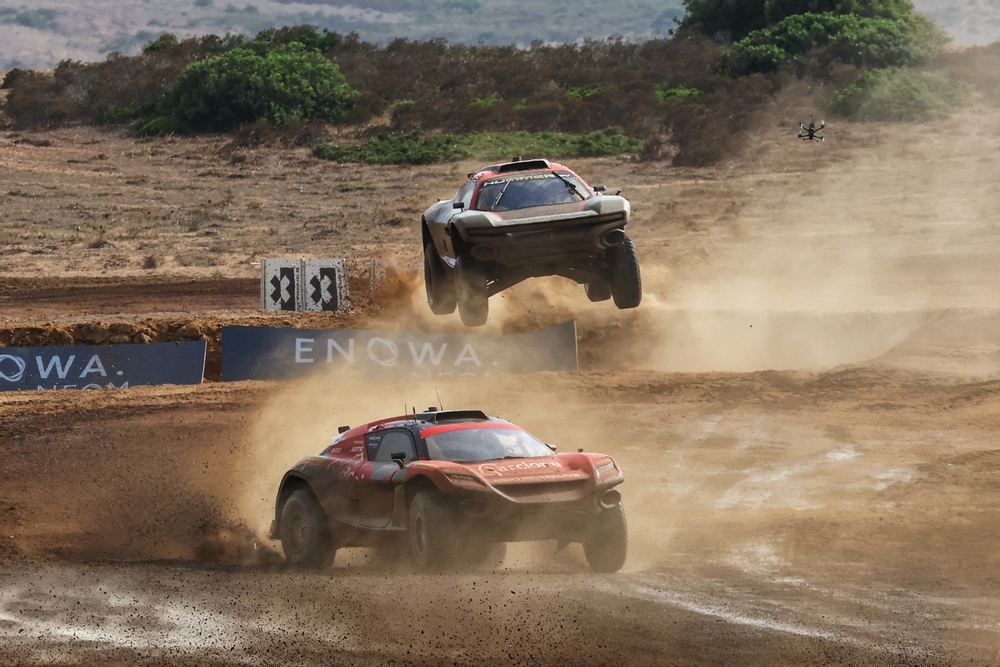Five rounds into the 2023 Extreme E all-electric off-road series, Rosberg X Racing (RXR) took its first victory of the season at the Island X Prix on Sardinia off Italy.
It was also the third time winning the event for the most successful team (owned by former F1 driver Nico Rosberg) in the series which has Mikaela Ahlin-Kottulinsky and Johan Kristoffersson as the crew this year.

Finishing second in the race, RXR inherited the win after on-course winners No.99 GMC HUMMER EV Chip Ganassi Racing received a 15.7-second penalty for a Switch Zone infringement. Promoted to second were ACCIONA | SAINZ XE Team, who gained extra championship points for a Heat win in Qualifying and recording the quickest time in the Continental Traction Challenge.

Disappointment struck for Andretti Altawkilat Extreme E, as Catie Munnings’ ODYSSEY 21, running in second place on the final lap, entered a roll off the back of an overtake by RXR’s Ahlin-Kottulinsky. Munnings came away unscathed, but the team were out of the Grand Final.
The winners of the Redemption Race were Kevin Hansen and Molly Taylor, gaining some crucial points to ensure that, despite losing the championship lead, Veloce Racing remain in contention.

Main race highlights
The day’s action came to a head in an exciting Grand Final, which saw all 5 ODYSSEY 21s (the specially designed electric SUVs for the event) converge into the left-hand lane for the first time on this course. No.99 GMC HUMMER EV Chip Ganassi Racing’s Anderson emerged in front, ahead of Andretti Altawkilat Extreme E’s Timmy Hansen.
Behind them Sebastien Loeb managed to secure third, ahead of ACCIONA | SAINZ XE Team’s Mattias Ekstrom. Meanwhile, RXR’s Kristofferson found himself off course in the bushes to the left as the cars ran out of room.

Ekstrom recovered well, hitting the brakes late to secure an overtake on Loeb, who continued to lose pace in his ABT CUPRA XE car due to a puncture. Kristoffersson soon took fourth from Loeb, closing in on the pack and getting ahead of Ekstrom as they entered the Switch Zone.
The front four were tightly packed as they left the Switch Zone, with Andretti Altawkilat Extreme E’s Munnings running wide as she pushed to defend against Ahlin-Kottulinsky, with the Swede sensing second place for RXR.

The RXR driver executed the crucial move on the final tour, pushing up the inside of Munnings’ ODYSSEY 21 on a tight left-hander. Following the contact between the two, the Andretti Altawkilat car continued to slide wide, eventually entering a roll that would put the team out of contention for the podium and down to fifth.
No.99 GMC HUMMER EV Chip Ganassi Racing’s Sorensen held onto the lead, but the team received a 15.7-second penalty for exiting their Switch Zone bay early. This dropped the American outfit into third place, but marks back-to-back podiums for Sorensen and Anderson.

ACCIONA | SAINZ XE Team finished third on-course, but moved up to second following No.99 GMC HUMMER EV Chip Ganassi Racing’s penalty. This marks a third podium of the season for the Spanish team as they replace Veloce Racing at the top of the championship standings by two points.

About Extreme E
Now in its third season, Extreme E is a radical off-road racing series, founded by the same team behind the all-electric single-seater Formula E championship. However, while Formula E is run on tarmac street circuits, Extreme E showcases electric SUVs and futuristic technologies in some of the world’s most remote and challenging environments.
The event utilises its sporting platform for the purpose of promoting electrification, environment and equality. Its goal is to highlight the impact of climate change in some of the world’s most endangered environments, promote the adoption of electric vehicles to pave the way for a lower carbon future, and provide a world-first gender-equal motorsport platform. In support of the latter objective, each crew must consist of one male and one female driver.

The ODYSSEY 21 SUVs which each team uses have been specially designed for the event. The vehicle has a common package of standardised parts, manufactured by Spark Racing Technology with an advanced 54 kWh battery pack produced by Williams Advanced Engineering. The drivetrain has a peak power output of 400 kW (550 bhp) which can rocket the 1,900-kg, 2.3-metre-wide SUV to 100 km/h in 4.5 seconds from standstill.
A unique feature of Extreme E is the transportation of the vehicles to each location. To reduce the event’s carbon emissions, a ship known as the St. Helena is used instead of aircraft.
This is a former Royal Mail cargo vessel that was refurbished and runs on low-sulphur marine diesel. The propellers have similarly been refurbished to reduce friction and improve efficiency. The underwater sections are painted in the most up-to-date anti-fouling paint, meaning she is kept clean which makes her more streamlined, while also reducing CO2 emissions.

The original 20-square metre swimming pool was replaced with a Science Laboratory. This facility allows researchers accompanying the event to carry out scientific activities at each location.

“The legacy and scientific aspects are a true cornerstone to the series. Even in the first year, we were able to conduct research in Saudi Arabia and collect ice and sediment samples from the Russell Glacier,” said Professor Carlos Duarte, who this year heads Extreme E’s Scientific Committee. “This series gives me and my peers the opportunity to reach people outside of our usual networks, it gives us a voice to reach the masses and educate on climate issues and the solutions we can all be a part of.”


